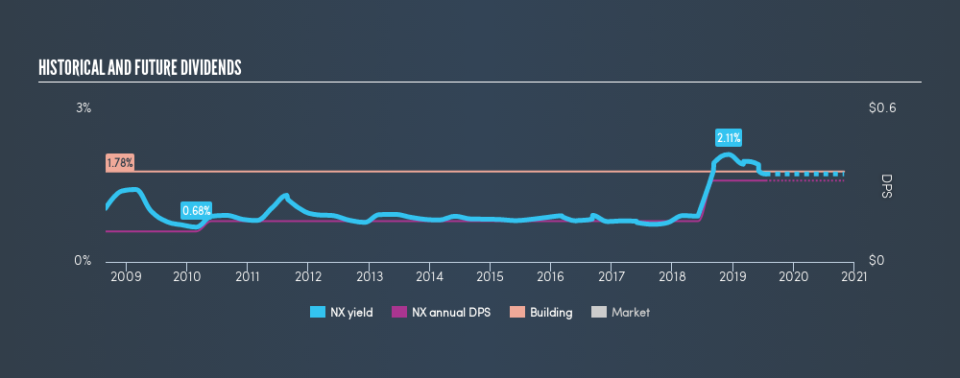Is Quanex Building Products Corporation's (NYSE:NX) 1.7% Dividend Worth Your Time?

Want to participate in a short research study? Help shape the future of investing tools and you could win a $250 gift card!
Today we'll take a closer look at Quanex Building Products Corporation (NYSE:NX) from a dividend investor's perspective. Owning a strong business and reinvesting the dividends is widely seen as an attractive way of growing your wealth. Yet sometimes, investors buy a popular dividend stock because of its yield, and then lose money if the company's dividend doesn't live up to expectations.
While Quanex Building Products's 1.7% dividend yield is not the highest, we think its lengthy payment history is quite interesting. The company also bought back stock equivalent to around 5.8% of market capitalisation this year. There are a few simple ways to reduce the risks of buying Quanex Building Products for its dividend, and we'll go through these below.
Click the interactive chart for our full dividend analysis
Payout ratios
Dividends are usually paid out of company earnings. If a company is paying more than it earns, then the dividend might become unsustainable - hardly an ideal situation. So we need to form a view on if a company's dividend is sustainable, relative to its net profit after tax. While Quanex Building Products pays a dividend, it reported a loss over the last year. When a company is loss-making, we next need to check to see if its cash flows can support the dividend.
Quanex Building Products's cash payout ratio last year was 16%, which is quite low and suggests that the dividend was thoroughly covered by cash flow.
Is Quanex Building Products's Balance Sheet Risky?
Given Quanex Building Products is paying a dividend but reported a loss over the past year, we need to check its balance sheet for signs of financial distress. A quick check of its financial situation can be done with two ratios: net debt divided by EBITDA (earnings before interest, tax, depreciation and amortisation), and net interest cover. Net debt to EBITDA is a measure of a company's total debt. Net interest cover measures the ability to meet interest payments. Essentially we check that a) the company does not have too much debt, and b) that it can afford to pay the interest. With net debt of 2.29 times its EBITDA, Quanex Building Products's debt burden is within a normal range for most listed companies.
Net interest cover can be calculated by dividing earnings before interest and tax (EBIT) by the company's net interest expense. With EBIT of 3.54 times its interest expense, Quanex Building Products's interest cover is starting to look a bit thin.
Remember, you can always get a snapshot of Quanex Building Products's latest financial position, by checking our visualisation of its financial health.
Dividend Volatility
From the perspective of an income investor who wants to earn dividends for many years, there is not much point buying a stock if its dividend is regularly cut or is not reliable. Quanex Building Products has been paying dividends for a long time, but for the purpose of this analysis, we only examine the past 10 years of payments. During this period the dividend has been stable, which could imply the business could have relatively consistent earnings power. During the past ten-year period, the first annual payment was US$0.12 in 2009, compared to US$0.32 last year. Dividends per share have grown at approximately 10% per year over this time.
It's rare to find a company that has grown its dividends rapidly over ten years and not had any notable cuts, but Quanex Building Products has done it, which we really like.
Dividend Growth Potential
While dividend payments have been relatively reliable, it would also be nice if earnings per share (EPS) were growing, as this is essential to maintaining the dividend's purchasing power over the long term. It's good to see Quanex Building Products has been growing its earnings per share at 26% a year over the past 5 years.
Conclusion
To summarise, shareholders should always check that Quanex Building Products's dividends are affordable, that its dividend payments are relatively stable, and that it has decent prospects for growing its earnings and dividend. We're not keen on the fact that Quanex Building Products paid dividends despite reporting a loss over the past year, although fortunately its dividend was covered by cash flow. That said, we were glad to see it growing earnings and paying a fairly consistent dividend. Overall we think Quanex Building Products is an interesting dividend stock, although it could be better.
Companies that are growing earnings tend to be the best dividend stocks over the long term. See what the 4 analysts we track are forecasting for Quanex Building Products for free with public analyst estimates for the company.
Looking for more high-yielding dividend ideas? Try our curated list of dividend stocks with a yield above 3%.
We aim to bring you long-term focused research analysis driven by fundamental data. Note that our analysis may not factor in the latest price-sensitive company announcements or qualitative material.
If you spot an error that warrants correction, please contact the editor at editorial-team@simplywallst.com. This article by Simply Wall St is general in nature. It does not constitute a recommendation to buy or sell any stock, and does not take account of your objectives, or your financial situation. Simply Wall St has no position in the stocks mentioned. Thank you for reading.

 Yahoo Finance
Yahoo Finance 
